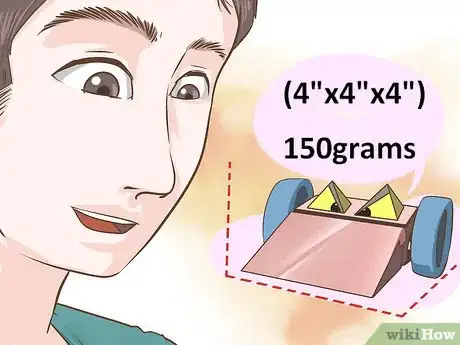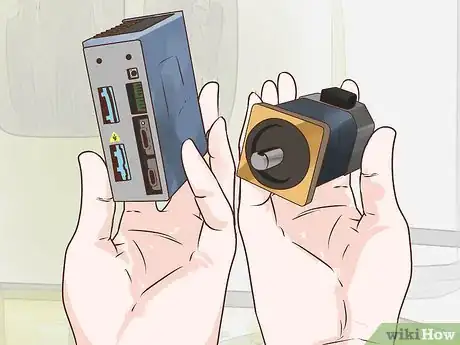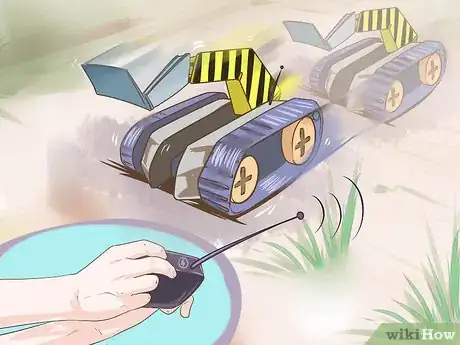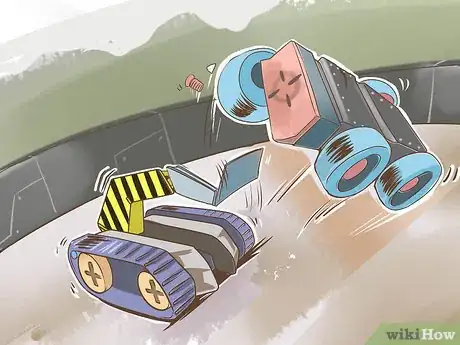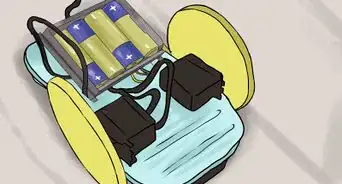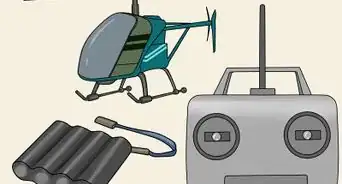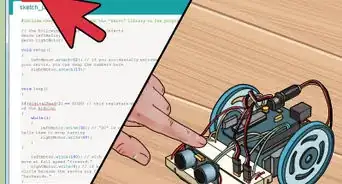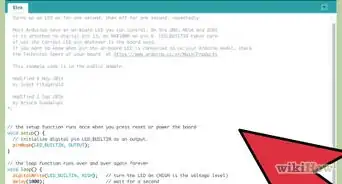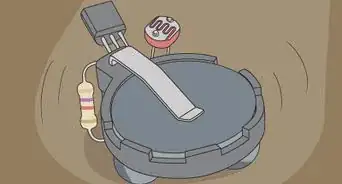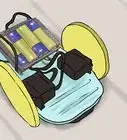wikiHow is a “wiki,” similar to Wikipedia, which means that many of our articles are co-written by multiple authors. To create this article, 25 people, some anonymous, worked to edit and improve it over time.
This article has been viewed 212,227 times.
Learn more...
Have you ever wanted to build a combat robot? You probably thought it was too dangerous and expensive. However, a lot of combat robot competitions have a weight class for 150 grams (5.3 oz), including Robot Wars. This class is called "Antweight" in most countries and "Fairy Weight" in the USA. These are a whole lot cheaper than the bigger combat robots, and aren't as dangerous. This makes them perfect for people new to combat robots. This article will tell you how to design and build an Antweight combat robot.
NOTE: This article assumes that you have already read and built an easy RC robot. If you have not, go back and do that first. It should also be noted that this article does not recommend a specific part for use with your robot. This is to promote creativity and diversity amongst robots.
Steps
-
1Understand the Rules Before designing a robot to compete, you must understand all the rules. The rules can be found here. The most important building rules that you need to be paying attention to are the size/weight requirements (4"X4"X4" 150 grams) and the metal armor rule that says you cannot have metal armor more the 1mm thick.
-
2What Weapon Will You Use? A big part of the combat robot is the weapon. Think up an idea for a weapon, but make sure it fits within the rules. For your first antweight bot it's highly recommended going with a "flipper" or even a "pusher". A flipper is just a weapon that wedges itself underneath another robot and pushes up to flip them over. A flipper weapon, when designed properly, can be the most effective weapon in the Antweight Class. A pusher is the simplest weapon because there is no active weapon. The whole robot acts as a weapon by pushing the other robots around. This is effective because of the rule that states that half of the arena can't be walled. You can push the other robot out of the arena.Advertisement
-
3Choose Your Parts.Yes, you need to choose your parts before designing. However, don't buy them, yet. Just choose your parts and design accordingly. If something doesn't fit or doesn't work while you are still designing, you save money because you can switch parts now. Again, do not buy the parts, yet!
- Choose Drive Servos It's usually recommended using servos instead of motors for an beginner's antweight because with servos, you do not need a speed controller which saves money and precious weight on your robot. You should look for "micro" servos because they will save you a lot of weight. Be sure to make sure the servo is 360 modifiable. It's recommended getting high torque servos for combat robots instead of high speed so it's easy to push other robots around, even if you have a separate weapon.
- If you cannot find a servo that suits your needs perfectly, consider checking out another section on that site that sells "Futaba" servos. Futaba is a different brand that makes servos. Sometimes they have different sizes than the HiTech brand.
- Choose a Weapon motor If you have an active weapon (i.e. aren't creating a "pusher"), then you probably need a motor to move the weapon. If you have a weapon that needs to move really fast (i.e. a spinning weapon), then you should get a geared DC motor (Brushless generally works better, but brushed would work) with a speed controller. It's not recommended using a spinning weapon for your first antweight because they can be difficult to build and balance properly. However, if you are creating a flipper weapon, then you want to use a servo. It's recommended to get a micro servo with extremely high torque so it can flip other robots with ease. Another thing to consider when looking for a weapon servo is the type of gears. If you use nylon gears and the motor gets a lot of stress, the gears can strip out over time. Try getting stronger gears made out of metal.
- Choose Wheels When choosing wheels, be sure to remember the rule that says the robot has to be able to fit within a 4"X4"X4" cube. This means you have to have wheels that have a diameter less than this. It's recommended to use 2" diameter wheel. Be sure that the wheels can easily attach to the servos securely. Another great technique to use in combat robots of any size is the ability to drive upside down. Yes, the controls will be a bit backwards, but it can prevent you from losing the competition from being immobile. So consider making your robot shorter than your wheels so that it can drive upside down.
- Choose a Transmitter/Receiver When purchasing a receiver make sure that it has what is called "Fail-Safe operation". It is a rule to have this in most competitions and a safety feature. The AR500 Receiver does not have this. You will need to purchase a BR6000 Bot Receiver, or another receiver that has this feature. For a transmitter it's recommended using the Spektrum DX5e. If you built the Remote Controlled Robot found in the related wikiHows, you can reuse that transmitter, but you must buy a new receiver.
- Choose a Battery It's highly recommended getting a LiPo battery instead of a NiMH battery. LiPo batteries are lighter. However, they are more dangerous, expensive, and require a special charger. Invest the money into a LiPo battery and a charger to save on the precious weight.
- Choose a Material The material the chassis and armor is made out of on a combat robot is extremely important because it is what prevents enemy weapons from piercing your electric components. There are three main choices that you should choose from: (Note: There are more, but these are the best for this particular weight class) Aluminum, Titanium, and Polycarbonate. Aluminum is light weight and strong, but it can be expensive and hard to cut. Plus it can not be more than 1mm at all. Titanium is light weight and extremely strong, but is hard to cut and extremely expensive. This also is subject to the 1 mm thickness rule. Polycarbonate, or lexan, is a lightweight, inexpensive, easy to cut, shatterproof, strong plastic that is sometimes used in bullet proofing. Polycarbonate is also a plastic so it can be as thick as you want, but it's recommended to get it about 1 mm thick. It's highly recommended using polycarbonate. It's so durable that this plastic is the plastic that makes up the arena walls for antweight competitions. When you purchase it be sure to get extra, in case you mess up.
- Choose Drive Servos It's usually recommended using servos instead of motors for an beginner's antweight because with servos, you do not need a speed controller which saves money and precious weight on your robot. You should look for "micro" servos because they will save you a lot of weight. Be sure to make sure the servo is 360 modifiable. It's recommended getting high torque servos for combat robots instead of high speed so it's easy to push other robots around, even if you have a separate weapon.
-
4Get Specifications Now that you have all your parts selected, you need to get size and weight specs. They should be listed on the website where you purchased them from. Convert all values in inches into mm using a converter. Write the specs (in mm) on a sheet of paper for all your components. Now, convert all weight values (oz, lb) into grams using a converter. Write the weight specs on a piece of paper.
-
5Design It Out You want the design to be as precise as possible. This means you should try your best to make the design 3D on a computer, rather than 2D on a sheet of paper. However, the 3D design doesn't need to look complex, a simple one made of rectangular prisms and cylinders will be sufficient.
- Add up the weight of the parts (in grams) and be sure they total less than 150 grams.
- If you don't have CAD, download the free version of Sketchup.
- Take some of the free tutorials on Sketchup to learn all the basics.
- Create all the components you are using on Sketchup using the size specs you wrote down.
- Design out your chassis and armor. Be sure to make it less than 4X4X4 inches.
- Fit all the components into the 3D chassis/armor model to see if they fit at the same time. This will also help you decide where the components will be.
-
6Order Your Parts If all your components fit into your design flawlessly, order your parts. If not, consider new parts.
-
7Assemble It Now, you need to put together your chassis/armor. Put all your components in where you put them in your design. Plug everything in and test it out. You should try to assemble it in a way that you can easily take out components in case they need to be replaced. The components may need to be replaced more than a regular robot because this robot will be fighting. The attacking robots could damage yours. It's recommended to use Velcro to hold the components in.
-
8Practice Driving No matter how good of a robot you have, if you fall off, you lose. Before even thinking about competing, you will need to practice driving. Use upside down cups for cones and drive through. Use Styrofoam cups for targets and attack them (try to do this on a small table so you can practice pushing them off and not falling off yourself). Even try to purchase a cheap RC car (on a different frequency as your robot), have another person drive it on a table, and try to knock them off or destroy the car, without falling off yourself. If you know another person with an Antweight robot, have friendly fights with him (if possible, replace spinning weapons with a less destructive plastic weapon).
-
9Compete Find a competition in your area and have fun destroying other robots! Remember that if you are going to compete in the US, you will need to look for Fairy Weight competitions, not Antweight..
Community Q&A
-
QuestionAre circuit boards needed? Is it possible not to use one?
 Community AnswerIt is possible to not use circuit boards and instead use certain programs on android phones to program your robot.
Community AnswerIt is possible to not use circuit boards and instead use certain programs on android phones to program your robot. -
QuestionCan a bot be made out of foam?
 Community AnswerUnless you want it to be destroyed, than no. You can always make a prototype out of foam, however.
Community AnswerUnless you want it to be destroyed, than no. You can always make a prototype out of foam, however. -
QuestionWhat kind of wheels should I use for the tank?
 Community AnswerTry putting a small rubber belt on some small tires so there is more friction with the ground, plus it looks cooler.
Community AnswerTry putting a small rubber belt on some small tires so there is more friction with the ground, plus it looks cooler.
Warnings
- Always wear safety glasses when cutting material or operating the robot.⧼thumbs_response⧽
- Even combat robots this small can be dangerous. If using a spinning weapon, stand back when operating it and unplug it when working on it.⧼thumbs_response⧽
- Some arenas are deemed unsafe for spinning weapons on robots. Do not try to use a spinning weapon in one of these arenas.⧼thumbs_response⧽
- Even micro pneumatics are dangerous. If using pneumatics be sure to follow all safety guidelines.⧼thumbs_response⧽
- LiPo Batteries are extremely dangerous. Do not charge them using a charger made for NiHM or Nicad batteries. LiPo batteries need a special charger.⧼thumbs_response⧽
- LiPo Batteries can catch fire if pierced. When designing your robot, try to place the battery somewhere that it won't get pierced. If the battery does catch fire, the rules state that you can not touch the robot while it's on fire. There will be no attempt made to put it out, which means all your other components could get ruined. Protect this battery like it's the heart of the robot!⧼thumbs_response⧽
Things You'll Need
2 Modified Drive Servos Material For the Robot Lipo Batteries Transmitter/receiver
